In high-rise apartments, private houses, public buildings and shopping malls, there are interfloor staircases. The most common way to decorate this structure and make it more comfortable is to put carpet on the stairs.
We will consider the most convenient fastening of carpet runners on the stairs, which is called a carpet holder.
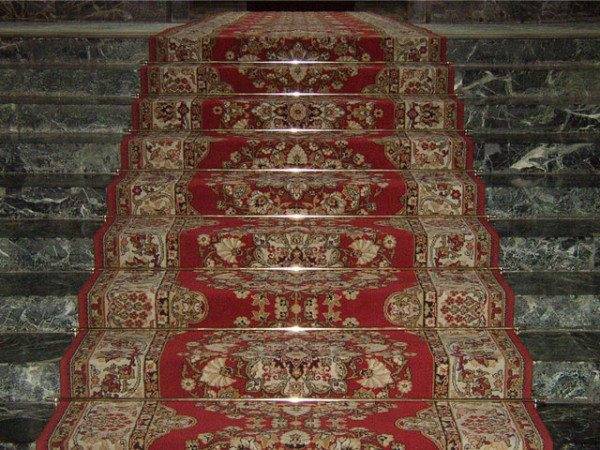
Methods for fixing carpets
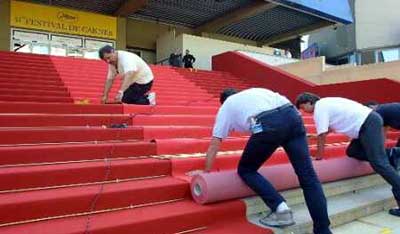
Staircase rugs can be installed in several ways:
- With glue, this method reliably fixes the carpet fabric on the plane of the steps and does not allow it to slide down when walking, which increases the reliability and safety of the covering;
- Using double-sided tape... This approach allows you to avoid damage to the carpet and steps with glue, and also makes it possible to replace the carpet for stairs without much effort, but the fixation is not very strong and reliable, especially after some time;
- With nails and buttons... The carpet holds well, but at the same time it becomes difficult to replace it, and the flooring and steps also suffer, as does the material of the carpet itself;
- By means of hold-down rails... The slats can be made by hand, installation is also simple, but it is quite difficult to make beautiful identical slats, process and paint them;
- With special clampswhen the rug to the stairs is inserted into a slot located on a metal or plastic batten fixed to the bottom corner of the riser and tread of the next rung. The method is elegant, but not very reliable;
- Carpet runners can be pressed onto stairs with special carpet holders... The method is quite reliable and proven, thanks to this it is very popular. The cover is perfectly fixed and can be easily removed without damaging the fabric and covering the steps.
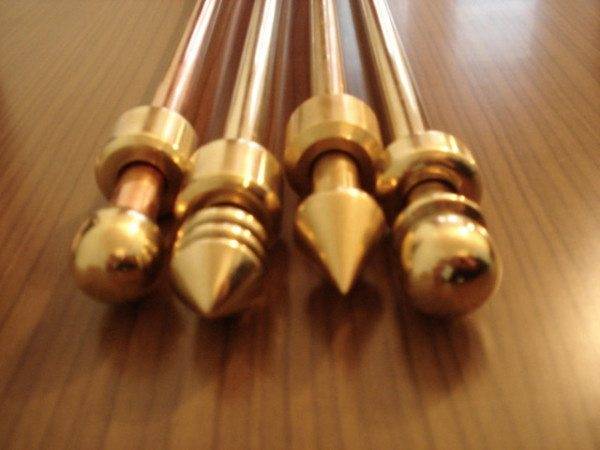
Fastening with glue
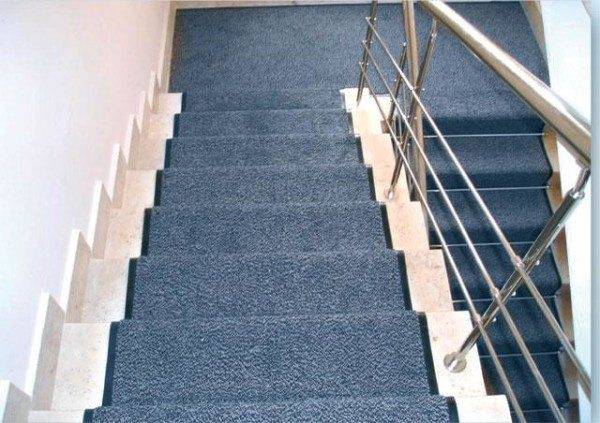
Using glue is the simplest and most obvious way to secure your rug to your stairs. At the same time, the fabric is tightly pressed against the steps, does not move, does not get confused, does not wrinkle and is securely fixed.
But there are a number of problems associated with this method of fixing:
- The coating firmly adheres to the surface of the interfloor structure, its replacement is difficult, it is often necessary to tear off the fabric in pieces, beat it off with chisels and other tools;
- After gluing and dismantling, the carpet most often falls into disrepair, and if we consider that the price of staircase coatings is quite high, then the use of glue looks uneconomical;
- When dismantling the fabric, the coating material of the steps and platforms of the entire structure deteriorates; some coatings, such as parquet, cannot be restored after that;
- Carpets for stairs, stained with glue, are not accepted for dry cleaning, which makes it difficult to care for them;
- You will not be able to move or re-move the carpet to another place, so it will wear out and become unusable faster.
Important!
When installing and fixing the carpet with glue, a clamp is often used between the spike strips, which leave folds and marks on the carpet that are difficult to get rid of.
As you can see, the use of glue is not the most rational way to secure carpets to the stairs.
Fastening with tape
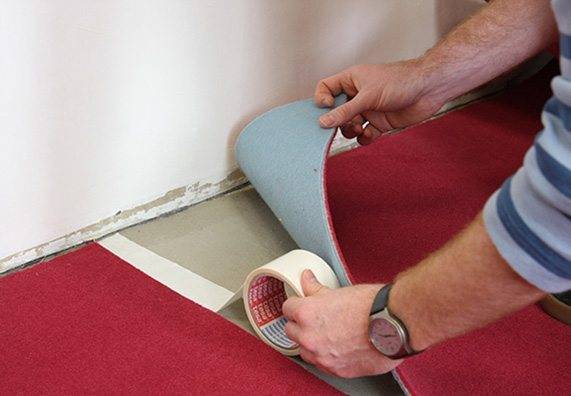
Another well-known method of mounting fabric coverings is to adhere them to a surface using double-sided tape. This is a fairly simple method in which there is no serious damage to the fabric or the surface of stair steps and landings.
But it has its own set of disadvantages:
- The fixation is incomplete, since in fact the material is held only in small strips, which make up a tiny percentage of the total area;
- Scotch tape loses its quality over time, and the material begins to peel off;
- The fixation is not strong enough for the stairs, since it is operated tightly in comparison with the rest of the floor, moreover, the flights of stairs are inclined, there are many vertical sections (risers), so the carpet tends to slide off, the gaps between the canvases expand and the coating loses its appearance.
Attention!
Do not forget that a staircase is an area of increased danger, especially for children, the elderly and the disabled.
Therefore, the reliable fixation of the carpet on this structure becomes a matter of life safety and requires a responsible approach.
Fastening with nails and buttons
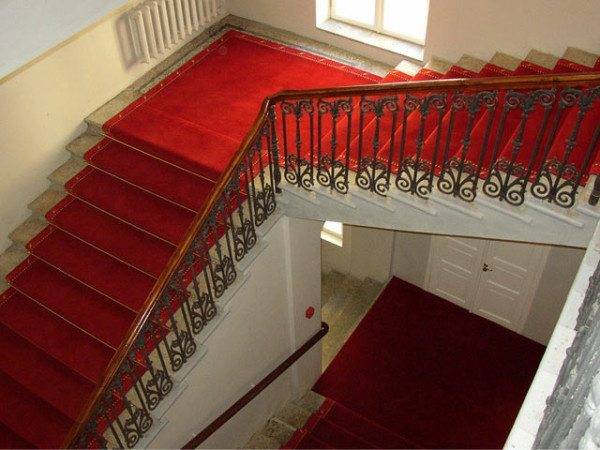
Attaching carpets to stairs with nails or buttons is also quite common. Nails hold the fabric of the carpet quite tightly and firmly, it does not move or slide out.
But there are also problems here:
- With each change of the coating, holes from nails remain in the steps and platforms, and the new holes do not coincide with the old ones, and the floor gradually turns into a sieve;
- Not every material can be pierced. Nails are relevant only for wooden products, as well as structures covered with parquet or board. Concrete, marble, metal or glass parts with buttons and nails are not compatible;
- The fabric has to be punched through, and after a few washes or movements, your carpet will be filled with holes.
Important!
If we consider that very expensive wood is usually used for the manufacture of stairs, which is processed and varnished, then we can conclude that fastening with nails is a far from perfect method.
Moreover, the dismantling of the coating causes a lot of difficulties, since it is not always possible to accurately and quickly remove the nails.
In the case of parquet, the use of buttons and nails takes on the form of ordinary barbarism, because to mutilate exquisite varnish, selected wood and an integral expensive coating is at least not smart.
Fastening with pressure rails
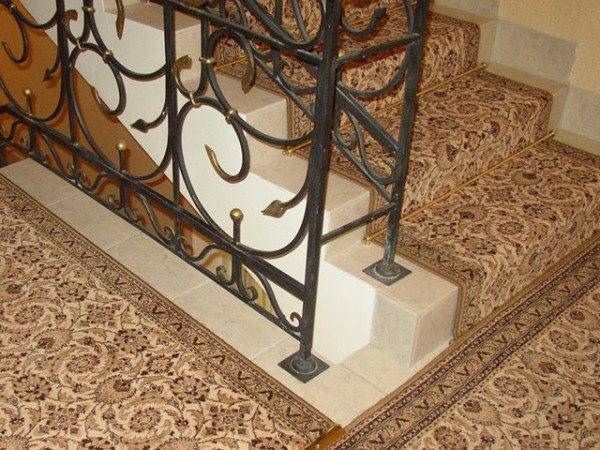
The use of home-made or factory-made wooden slats is, in general, an imitation of specialized carpet holders, which will be discussed below.
The principle of operation is simple:
- In the corner between the riser and the tread of the lower step, a wooden lath is installed with a gap slightly thinner than the thickness of the carpet layer.
- At the edges, the rail is nailed to the step, or fastened with screws and other fasteners, depending on the material of which the structure consists.
With this method of fastening, the carpet is held firmly enough, and it can be easily removed by unscrewing the screws and removing the rail.
But there are also disadvantages:
- Wooden slats, as a rule, are not properly processed, and quickly deteriorate by rodents, insects, natural biological and chemical corrosion;
- Homemade slats look specific and are not suitable for every interior. They will look harmoniously in traditional and folklore styles, but at the same time they will be out of place in modern and classical styles of interior design;
- Wood is not as strong as metal, so you will need a bar that is too thick for a strong fix. In addition, wood can change shape and size depending on humidity and temperature, which can also cause a lot of problems.
Advice!
Wooden slats can be used in country houses where natural and natural materials are welcome.
Clamping
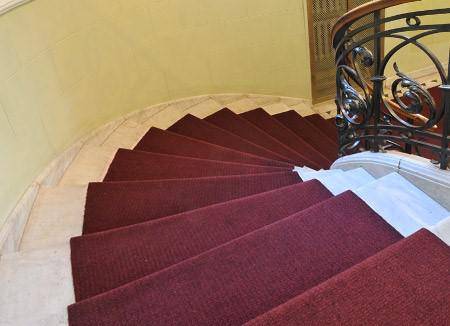
Fastening takes place as follows: at the junction between the riser and the tread of the lower step, a special metal or wooden structure is attached, which is a rail with a slot equal to the double thickness of the carpet.

Next, the carpet is pushed into this gap using a chisel. Most often, this method is combined with glue or tape, as well as nails. The option itself is not reliable enough, since the fabric can easily fly out of the clamp under heavy loads.
It should also be noted that changing the carpet is easy, and there are no slats, bars or other exposed fasteners left on the step. But strong folds remain on the fabric, and if thorns are used in the clamp, then holes may remain.
Advice!
Considering the danger that can be caused by a sliding staircase carpet, we do not recommend using the clamps as an independent fastening.
As you can see, all of the above methods are not reliable enough, or cause difficulties and problems.
Carpet holders

Carpets on metal stairs are ubiquitous. This is the most convenient, reliable, and therefore the most common mount.
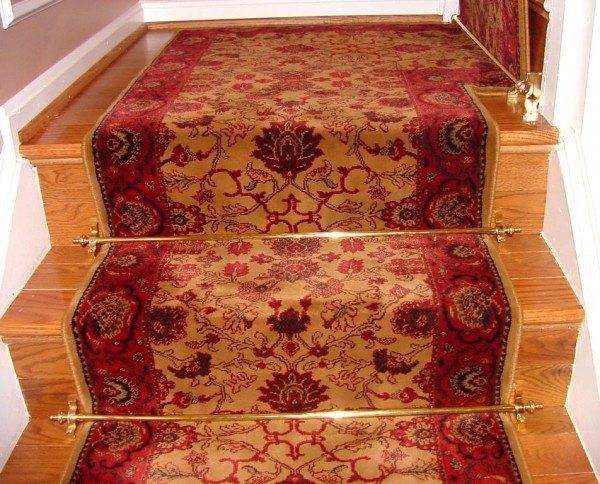
The product is a structure consisting of several parts:
- A bar or tube that presses and holds the fabric on the rungs, called a barbell;
- Clamps that attach the bar to the structure at a certain distance;
- Bar ends for an aesthetic function and help to fix the bar more accurately;
- Fasteners with which the clips are screwed to the steps.
With the help of such carpet holders, it is very easy to assemble and dismantle any carpet, and damage to the carpet or staircase does not occur. This is very convenient, because you have the opportunity to remove, replace or send the carpet runner for washing at any time. If you buy two or more coatings, you can easily change them for the duration of the wash or during the holidays, meetings, celebrations.
It should also be said that the carpet holders are made of non-ferrous metals and their alloys:
- Brass;
- Copper;
- Bronze;
- Of stainless steel;
- Duralumin;
- Galvanized metal.
These products look quite presentable and even luxurious, as they imitate gold and silver. They easily fit into a wide variety of design styles: classic, country, gothic, modern, hi-tech.

Fastening the carpet to the stairs is tight, strong and reliable. The use of carpet holders saves you the risk of falling down stairs due to displacement of the covering, and also greatly simplifies maintenance, installation work and replacement of carpets.
The instructions for using such fasteners are very simple: just disconnect the rod and remove the cover. After that, you can immediately lay a new one, and then press it down with the rods. Obviously, this is the most rational, reliable and thoughtful way to fix the carpet on the stairs.
Output
Carpets decorate the stairs, increase their comfort, reduce walking noise and make the flooring pleasant to the touch. But fixing the coverings on the steps often causes difficulties, which are solved by using special carpet holders.
In the video presented in this article, you will find additional information on this topic.






